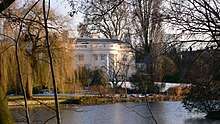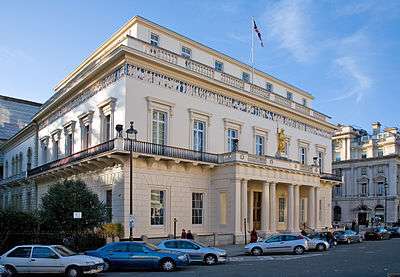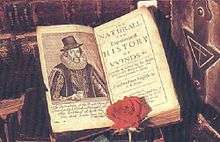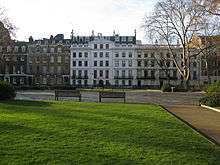James Burton (property developer)
| James Burton | |
|---|---|
_at_St_Leonards-on-Sea.jpg) Pyramidal Tomb of James Burton (1761 - 1837) and Burton family at St Leonards-on-Sea, England. | |
| Born |
29 July 1761 London, England |
| Died |
31 March 1837 St Leonards-on-Sea, England[1] |
| Residence |
|
| Education | Homeschooled |
| Occupation | Property developer, architect |
| Notable work | |
| Children |
10 that survived infancy, including: |
| Parents |
|
| Relatives | |
James Burton (born James Haliburton) (29 July 1761 – 31 March 1837) was the most successful property developer of Regency and Georgian London: he was "probably the most significant builder of Georgian London."[2] He built the majority of the Bloomsbury district; Chester Terrace, Cornwall Terrace, Clarence Terrace, and York Terrace at Regent's Park; and much of the Bedford Estate including Russell Square and Tavistock Square. James financed and built the projects of John Nash around Regent’s Park, most of which were predominantly designed by James's son, Decimus Burton, rather than by Nash himself. Such were James Burton’s contributions to the project that the Commissioners of Woods described James, not Nash, as ‘the architect of Regent’s Park’.[3] James also conceived, planned, and developed the town of St Leonards-on-Sea, now part of Hastings. By the time of his death, Burton had built over 3000 properties,[1] and his buildings covered over 250 acres of London.
James was a leading member of London society. He was an early member of the Athenaeum Club, London, whose Clubhouse he built to his son's design, Master of the Worshipful Company of Tylers and Bricklayers, and Sheriff of Kent. James was the father of William Ford Burton, the gunpowder manufacturer, James Burton, the Egyptologist, Henry Burton, the physician, and Decimus Burton, the architect, amongst others, and the grandfather of Henry Marley Burton, the architect, and Constance Mary Fearon, the founder of the Francis Bacon Society.

Family
James Burton was born as James Haliburton on 29 July 1761, son of William Haliburton (1731–1785), a London property developer of Scottish descent,[4] and Mary Johnson (1735–1785), daughter of Nicholas Foster of Kirkby Fleetham, Yorkshire.[5][1] William Haliburton was the second husband of Mary Foster.[5] They married in 1760.[5] They had two children, James and another who died in infancy.[1][5] Burton's father William Haliburton's paternal grandparents were Rev. James Haliburton (1681–1756) and Margaret Eliott, daughter of Sir William Eliott, 2nd Baronet and aunt of George Augustus Eliott, 1st Baron Heathfield.[5] They had 7 daughters and 2 sons,[5] William (father of James), and Andrew.[5] James Burton's father William was descended from John Haliburton (1573–1627), from whom Sir Walter Scott, 1st Baronet was descended on the maternal side.[2] Burton was a cousin of the Canadian author and barrister Thomas Chandler Haliburton and of the British civil servant Lord Haliburton.[4][6][7]
James (b.1761) was christened with the 'James Haliburton' at Presbyterian Chapel, Soho, London.[5] He shortened his surname to Burton in 1794, subsequent to a dispute with his family,[2][4] between the birth of his fourth child and the birth of his fifth child.[5]

Education
James was educated at a day school in Covent Garden before being privately tutored. In July 1776 he was articled to a surveyor named Dalton, with whom he remained for six years.[8]
Property developments
- St Leonards-on-Sea[1]
- Russell Square[1]
- Bloomsbury Square and surrounding streets[1]
- St John's Wood[9]
- Burton Street and Burton Crescent (now Cartwright Gardens)
- Tavistock Square, including Tavistock House (for himself)[1]
- The Holme, Inner Circle, Regent's Park.[1] It was designed by James's son, Decimus Burton and built by James. The residence of the Burton family. Architectural critic Ian Nairn wrote of the house, "If you want a definition of western civilization in a single view, then here it is".[10]
- York Terrace, Regent's Park[1]
- Chester Terrace Regent's Park[1]
- Cornwall Terrace, Regent's Park[1]
- Clarence Terrace, Regent's Park[11]
In 1787, Burton was already known as architect and builder in Southwark, having built the Blackfriars Rotunda in Great Surrey Street (now Blackfriars Road) to house the Leverian Museum for land agent and museum proprietor James Parkinson.[12]
When 28 years of age, Burton made his first proposition to build on the land made available by the Foundling Hospital. In 1792, he asked the Foundling Hospital Governors for a permission to build on the whole of Brunswick Square. They underestimated Burton's ability, and declined to waive their principle of not allowing any one speculator to develop more than a small proportion of the ground, and Burton was granted only a small part of land on the south side and part of Guildford Street. Subsequently, however, he rapidly expanded this estate with further purchases until he owned most of the western property: by 1802 he had built nearly 600 houses on the estate.[13]
In 1800, Burton bought the Duke of Bedford's London mansion, Bedford House, and began to lay out houses over its site (facing Bloomsbury Square); to create Russell Square; and to build the south side of Russell Square. Burton exhibited a view of these houses in the Royal Academy Exhibition 1800. In 1807 he continued his Bloomsbury development north, and he was also involved in the early development of St John's Wood[9] He then left London for a project in Tunbridge Wells but returned in 1807 to build over the Skinners Company ground between the Bedford Estate and the lands owned by the Foundling Hospital, where he built Burton Street and Burton Crescent (now Cartwright Gardens), including, for himself, the villa Tavistock House, on ground now occupied by the British Medical Association, where he lived until he moved to The Holme in Regent's Park, which was designed for him by his son Decimus Burton.[13]
Relationship with John Nash
Subsequent to the Crown Estate's refusal to finance them, James Burton agreed to personally finance the construction projects of John Nash at Regent’s Park, which he had already been commissioned to construct. In return, Nash agreed to promote the career of James's son, Decimus Burton. Such were James Burton’s contributions to the project that the Commissioners of Woods described James, not Nash, as ‘the architect of Regent’s Park’.[3] Contrary to popular belief, the dominant architectural influence in many of the Regent's Park projects - including Cornwall Terrace, York Terrace, Chester Terrace, Clarence Terrace, and the villas of the Inner Circle, including The Holme - was Decimus Burton, not John Nash, who was appointed architectural 'overseer' for Decimus's projects.[3] To the chagrin of Nash, Decimus largely disregarded his advice and developed the Terraces according to his own style, to the extent that Nash sought the demolition and complete rebuilding of Chester Terrace, but in vain.[14][1] Decimus also emerged as the dominant force in the design of Carlton House Terrace.
Gunpowder manufacturer
In addition to his property development enterprises, James Burton, together with his eldest son, William Ford, owned and managed a successful gunpowder manufacturing enterprise, based at Powder Mills, Leigh, from his office in the City of London.[15][16][1] The mills, which were initially known as the Ramhurst Powder Mills,[17] and later as the Tunbridge Gunpowder Works, were that he established in 1811 in partnership with Sir Humphry Davy.[18][19][20][15][1] After the retirement of James Burton in 1824,[17] William Ford became the sole owner of the mills until his death in 1856,[17][18] at which point the gunpowder business to his brother, Alfred Burton JP, Mayor of Hastings.
Personal life
James's residences were Tavistock House (later the residence of Charles Dickens), The Holme, and Mabledon House, Kent.[1] The family also had offices at Spring Gardens, Westminster,[21] Old Broad-Street, City of London,[15] and Lincoln's Inn Fields, where Septimus Burton was a solicitor at Lincoln’s Inn,[22][6] where he trained William Warwick Burton,[23] who was a resident.[24]

James Burton was an early member of the Athenaeum Club, London, as was his son, Decimus Burton.[25] Burton was Master of the Worshipful Company of Tylers and Bricklayers in 1801–2. Burton served as Sheriff of Kent in 1810.[1]
In 1804, in response to the cessation of amicable relations with the French Republic, Burton raised a 1600 strong company of volunteers, the Loyal British Artificers, at his own expense, which was recruited from the large body of artificers that were in his employ, and of which he made himself colonel.[8]
He attended the funeral of Horatio Nelson in 1806.[8]
James is buried in a distinctive pyramidal tomb in the churchyard of St Leonards-on-Sea.[1]
Marriage and children
On 1 March 1783, at St. Clement Danes, London, James Burton married Elizabeth Westley (12 December 1761 – 14 January 1837), of Loughton, Essex, daughter of John and Mary Westley.[5] They had six sons and six daughters:[5]
- William Ford (11 January 1784 – 18 October 1856).[5] William Ford was named after his maternal granduncle, William Ford. He was prevented from attending university by a severe injury caused by a fall from his horse in 1806. He began farming with his father in 1807.[6] The office of the Burton family was in the City of London,[15][16] from which William Ford managed the Powder Mills, Leigh - which were initially known as the Ramhurst Powder Mills,[17] and later as the Tunbridge Gunpowder Works – that he established in 1811 in partnership with his father, James Burton, and Sir Humphry Davy,[18][19][20][15][1] both of whom were early members of the Athenaeum Club, London. Subsequent to the retirement of James Burton in 1824,[17] William Ford became the sole owner of the mills until his death in 1856,[17][18] at which point the gunpowder business to his brother, Alfred Burton JP, the Mayor of Hastings. William Ford lived at St John's Wood, The Holme, and South Lodge, St. Leonards-on-Sea.[6] He never married but had two illegitimate sons:[6][23][1] Henry Marley Burton FRIBA (1821 - 1880) and William Warwick Burton[23] (d. 21 October 1861).[24][26] Henry Marley was baptized as Henry Marley on 12 Dec 1821: at his baptism, he was claimed to be the son of William Marley and Sally Marley, London neighbours of the Burtons.[23] Henry Marley had at least one son, Edgar Burton, also an architect.[27] William Warwick Burton lived at Lincoln's Inn Fields,[24] where he was articled as a solicitor to his uncle, Septimus Burton (1794 - 1842)[23] of Lincoln’s Inn.[22][6] William Warwick Burton had three children, William Edgar Burton, Edmund Burton, and Jessy Burton,[28] each of whom were left property in the will of their uncle, Decimus, who never married and died without issue.[23]
- Emma Elizabeth (4 August 1785 – 13 December 1785). She died from smallpox.[5]
- Eliza (29 September 1786 – 6 February 1877).[5] She lived for a time at No.36 Marina and later at No. 5 West Hill in St. Leonards-on-Sea. She did not marry.[1][8][6]
- James FGS (22 September 1788 – 22 February 1862).[5] Egyptologist.[7][29][6]
- Emily (10 August 1791 – 20 May 1792).[5][6]
- Jane (4 April 1792 – 11 December 1879).[5][22][6] She married Thomas Walker[30] (who changed his surname to Wood[22] in 1817)[30] of Tonbridge, at Tonbridge, in 1812.[30] She had 1 son George James (1813–1831) and 3 daughters, Emily (1815–1892), Helen (1816–1903) and Rose Anne (born 1818).[30][22] She and her daughters lived at North Lodge, St. Leonards-on-Sea.[22][8]
- Septimus (27 July 1794 – 25 November 1842).[5][22][6] Septimus was educated at Lincoln's Inn, where he was articled to J. W. Lyon in 1810, and, subsequently, established his legal practice.[22] He dealt with much of his father’s business. He married Charlotte Lydia Elizabeth Middleton in 1824.[31] They had 1 son, Arthur (b.1830)[31] who married Lilian Margaret Robertson in 1860 and one son, Francis Arthur (1861–64). Septimus lived at Serle Street, Lincoln's Inn Fields. He died on 25 November 1842, and is buried at Chiswick.[31]
- Octavia (b. 20 May 1796).[5] She married Edmund Hopkinson,[32][33] a banker, at Tonbridge, in 1813.[32] No issue.[6]
- Henry FRCP (27 February 1799 – 10 August 1849).[5] Physician and chemist, discoverer of the Burton line.[6] He married Mary Elizabeth Poulton (1800 - 1829) in 1826 at St. George's, Bloomsbury.[34]
- Decimus FRS FRSA RA FSA FRIBA (30 September 1800 – 14 December 1881).[5] Architect.[8][6][35]
 Burton 's granddaughter, Constance Mary Fearon, was the founder of the Francis Bacon Society.
Burton 's granddaughter, Constance Mary Fearon, was the founder of the Francis Bacon Society. - Alfred (18 June 1802 – 24 April 1877)[5] JP. Mayor of Hastings, manager of the Burton estates, and Secretary to Decimus Burton and Thomas Wood (the husband of Jane Burton). In St. Leonards-on-Sea, Alfred Burton was Steward of the Races; President of the Mechanics Institute; Vice-President of the Infirmary; and Trustee of Hastings and Flimwell Turnpike. He was a member of the Queen’s Royal St. Leonards Archers.[6] He was a long-standing member of the Oriental Club, to which he donated numerous books and pictures,[36] and to which his brother Decimus and nephew Henry Marley Burton made architectural additions.[37] Alfred married Anna Delicia Adams in 1843.[38] They had one son, Alfred Henry (1845–1917),[38] of Hastings Lodge, JP, High Sheriff of Sussex in 1902, who married Ellen Amelia Dickson, and had four children, and one daughter Louisa Charlotte (1849–1873),[38] who did not marry.
- Jessy (12 April 1804 – after 24 April 1844).[5][22][6] She married John Peter Fearon (1804–1873),[39][22] a lawyer of Great George Street, Westminster, in 1833.[39][8] She lived in Regent's Park.[22] She had 3 daughters, Jessy Tyndale (1834–1910),[39] Constance Mary (1835–1915),[39] and Ethel Anna (1839–1901)[39] (who married Thomas Ayscough, and had issue) and one son, Francis (1837–1914)[39] (who married Julia Mary Woodward, and had issue).[8] Jessy's middle daughter, Constance Mary Fearon, was the founder of the Francis Bacon Society and author (under the pseudonym Mrs Henry Pott) of numerous books advocating the theory that Francis Bacon, 1st Viscount St. Alban was the author of the works attributed to William Shakespeare.[40]
References
- 1 2 3 4 5 6 7 8 9 10 11 12 13 14 15 16 17 18 19 20 21 "James Burton [Haliburton]", Oxford Dictionary of National Biography".
- 1 2 3 "Who were the Burtons?". The Burtons' St Leonards Society. Retrieved 18 June 2016.
- 1 2 3 Arnold, Dana (2005). Rural Urbanism: London Landscapes in the Early 19th Century. Manchester University Press. p. 58.
- 1 2 3 Davies, Richard A. (2005). Inventing Sam Slick: A Biography of Thomas Chandler Haliburton. University of Toronto Press. p. 71-73.
- 1 2 3 4 5 6 7 8 9 10 11 12 13 14 15 16 17 18 19 20 21 22 23 "Pedigree of Decimus Burton, The Weald Archives".
- 1 2 3 4 5 6 7 8 9 10 11 12 13 14 15 16 Burton, James (1783–1811). "The Diary of James Burton". The National Archives. Retrieved 2018-06-18 – via Hastings Museum and Art Gallery.
- 1 2 "Haliburton [Haleburton; formerly Burton], James (1788–1862), Egyptologist".
- 1 2 3 4 5 6 7 8 J. Manwaring Baines F.S.A., Burton’s St. Leonards, Hastings Museum , 1956.
- 1 2 Victoria County History: Middlesex and London. Celebrating the birth in July 1761 of James Burton, the founder of St Leonards-on-Sea and builder-developer in Bloomsbury. Accessed: 18 June 2016.
- ↑ Nairn, Ian (1966). Nairn's London (first ed.). p. 87. ISBN 978-0141396156.
- ↑ "Entry for Burton, Decimus, in Dictionary of Scottish Architects". Retrieved 20 March 2017.
- ↑ Torrens, H. S. "Parkinson, James (bap. 1730, d. 1813), land agent and museum proprietor". Oxford Dictionary of National Biography (online ed.). Oxford University Press. doi:10.1093/ref:odnb/21370. (Subscription or UK public library membership required.)
- 1 2 Summerson, John (1962). Georgian London (First ed.). Pimlico.
- ↑ Curl, James Stevens (January 2006). "Burton, Decimus (1800–81) :". A Dictionary of Architecture and Landscape Architecture. doi:10.1093/acref/9780198606789.013.0745. Retrieved 2016-08-22.
- 1 2 3 4 5 "No. 18156". The London Gazette. 8 August 1873. p. 1271.
- 1 2 "Trade Card of James and William Burton of Tunbridge Mills, Kent". Victoria and Albert Museum, London. Retrieved 17 March 2017.
- 1 2 3 4 5 6 Rowley, Chris (Spring 2006). "Sulfur and its Role in Gunpowder; Leigh Gunpowder Works, Kent". Gunpowder and Explosives History Group. No. Newsletter 12. Royal Society of Chemistry, Burlington House, Piccadilly, London, W1J 0BA: Royal Society of Chemistry Historical Group; Gunpowder and Explosives History Group.
- 1 2 3 4 "Tonbridge History: Gunpowder". Tonbridge History. Retrieved 17 March 2017.
- 1 2 Crocker, Glenys (2007). "Black Powder Manufacturing Sites in the British Isles". Gunpowder Mills Gazetteer. Mills Archive Trust.
- 1 2 "Transactions of the Royal Society of Arts, London". Transactions of the Royal Society of Arts, London. 37: 162–163. 1819.
- ↑ Burton, Decimus, Oxford Dictionary of National Biography
- 1 2 3 4 5 6 7 8 9 10 11 Davies, Richard A. (2005). Inventing Sam Slick: A Biography of Thomas Chandler Haliburton. University of Toronto Press. p. 72.
- 1 2 3 4 5 6 "William Ford Burton, Leigh & District Historical Society". 2017.
- 1 2 3 "No. 22910". The London Gazette. 11 November 1864. p. 5337.
- ↑ "Athenaeum Club, London. Homepage".
- ↑ "No. 22908". The London Gazette. 4 November 1864. p. 5231.
- ↑ "Fountain Design of Edgar Burton to commemorate James Burton". Retrieved 20 February 2016.
- ↑ "Cause number: 1857 B152: In the Matter of William Edgar Burton, Edmund Burton, and Jessy Burton".
- ↑ Tour Egypt - The Egyptologists
- 1 2 3 4 "Pedigree of Jane Burton, The Weald Archives".
- 1 2 3 "Pedigree of Septimus Burton, The Weald Archives".
- 1 2 "Pedigree of Octavia Burton, The Weald Archives".
- ↑ Davies, Richard A. (2005). Inventing Sam Slick: A Biography of Thomas Chandler Haliburton. University of Toronto Press. p. 71.
- ↑ "Pedigree of Henry Burton, The Weald Archives".
- ↑ Dictionary of National Biography, Biographical Dictionary of the English Architects, 1660–1840 by H. M. Colvin, 1954, and The Life and Work of Decimus Burton by R. P. Jones in the Architectural Review, 1905
- ↑ Baillie FRGS, Alexander (1901). The Oriental Club and Hanover Square. Longmans, Green, and Co. p. 152.
- ↑ Baillie FRGS, Alexander (1901). The Oriental Club and Hanover Square. Longmans, Green, and Co. p. 167.
- 1 2 3 "Pedigree of Alfred Burton (1802 - 1877), The Weald Archives".
- 1 2 3 4 5 6 "Pedigree of Jessy Burton (1804 - 1877), The Weald Archives".
- ↑ "Francis Bacon Society Library, Senate House Library, London".
Further reading
- "James Burton [Haliburton]", Oxford Dictionary of National Biography".
- "Pedigree of Decimus Burton, The Weald Archives".
- "The Burton's St Leonards Society".
- John Summerson, Georgian London, Pimloco, 1962
- Burton’s St. Leonards, by J. Manwaring Baines F.S.A., Hastings Museum, 1956.


